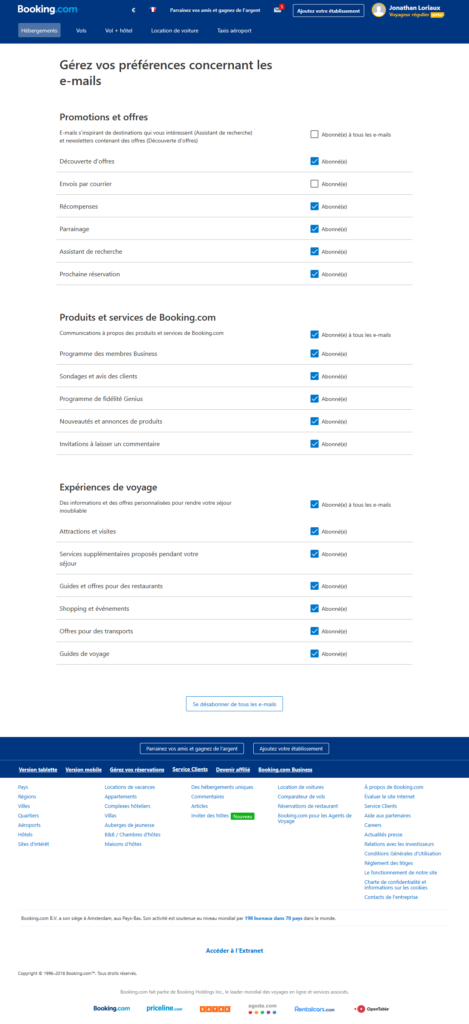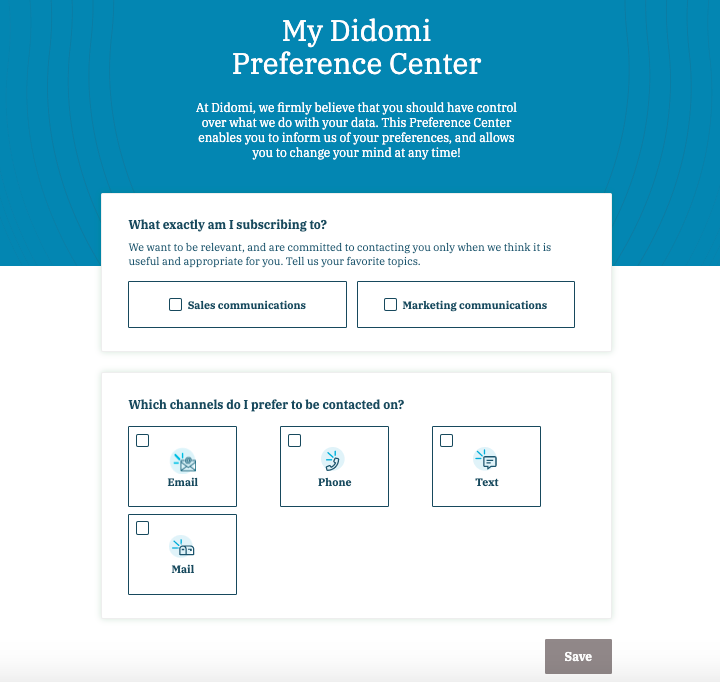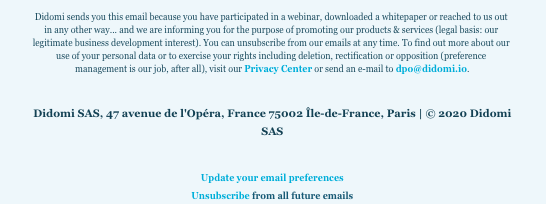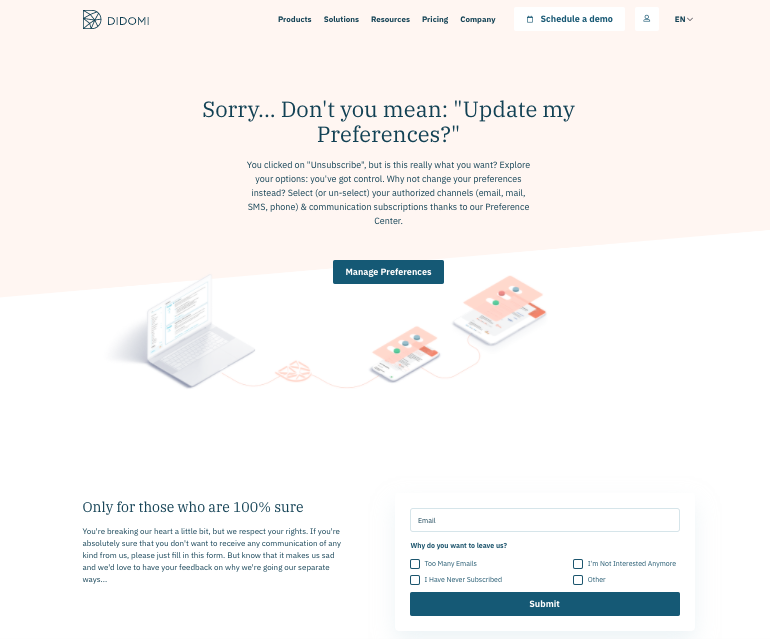Thursday, April 29, we organized a live with Didomi about the Preference Center. It is a current topic that can be quite complex, which requires, in any case, to be well framed. The objective of this live was to define The main steps in setting up a Preference Center.
I took the opportunity to ask a lot of questions to Arnaud Courtel and Yannig Roth2 experts on the subject.
The live replay
Now it's time for the questions and answers.
Why do your customers decide to set up a preference center? What was the trigger?
It doesn't necessarily come from an email-only logic, it comes from a reflection that comes :
- from LEGAL Who wants to do some work on RGPD compliance. The DPO is now very concerned about cookies and consent for emailing and other channels.
- of the party DATA They have contact points (postal data, emailing, telephones...) all over the information systems, they need to take stock and know where they stand, show their customers what kind of data they have on them and show whether or not they have the right to communicate with them.
- of the party MARKETING who wish to collect and know the preferences/centers of interest of their contacts in order to improve their targeting and personalization strategy of communications.
They need to centralize it all in one place.
Such a subject requires an important phase of reflection with, like any phase of reflection, the organization of a workshop. Who do you recommend to invite to this phase of reflection?
In general, there are always three professions represented. Sometimes three people intervene at the beginning of the reflection or they intervene in turn, sometimes at the beginning, in the middle or towards the end of the reflection.
- people from the party Digital/MarketingThe people who deal with the CRM part, activation of emailing/direct marketing campaigns.
- people from the Legalwho is in charge of the concrete implementation of the flows and legal processes of RGPD consent.
- Then, if the subject is complex, there are also people who deal with thedata architecture, tools, to see how the tools connect to each other, can the APIs talk to each other, can we centralize everything, can we do it in real time or not...
It can also be a good idea to get the various consultants who work with advertisers (legal, data or marketing consultants) around the table. Arnaud adds that it is also very important that the designers are involved because the user experience part is very important when designing the Preference Center.
It is also important to present the implementation of the Preference Center project to everyone in the company, as sales teams, for example, who are often in contact with customers, can have good ideas and contribute to the success of a Preference Center.
How can we structure this reflection? What questions should we ask ourselves to have an efficient Preference Center?
First, there is a Legal audit How are we doing with the RGPD? Are we good in terms of consent? Do we have all the evidence we need?
Then there is a Marketing Audit How many brands are we communicating through? Do we need a preference center per brand? or a central preference center? in how many and in which tools are these consents hosted? are there communication channels that we want to push? What are the different types of communications we send to our customers? What are the top 3 preferences/centers of interest that are worth asking? (example: "your favourite shop", "your favourite sport"...) We need to think about the 3 main areas of interest that would allow us to optimise a segmentation strategy.
There is a Data/SI AuditDefine the technical specifications: what type of authentication? what integrations & APIs to use?
Doesn't the decision to implement a branded or global PC depend on how you collect the opt-in: whether you collect a group opt-in or a branded opt-in from the start?
Not necessarily. If you have aencourage opt-in to different brands or channelsIt can be interesting to have a global preference center.
We often see the PC as a tool that allows us to unsubscribe from certain communications, but we must also see the PC as a tool that allows us to subscribe to other communications, and therefore to other brands.
How far should a PC go to be effective and well used? Should we make it as simple as possible like indicating the types of adhesions to email campaigns? Or on the contrary, should we take the opportunity to collect a lot of data such as the frequency of reception of emails? The channels? The collection of interests?
It's very varied but I think you have to keep it simple otherwise you lose the user. But still, if I'm a private sale player and I can offer my contacts to subscribe to brand alerts, it's a great feature if and only if it's well respected in terms of communication. But if I have 150 brands to offer and 150 boxes to check, it becomes indigestible for the user. So we'll have to find a design trick that will improve the user experience and make it easier for the user to digest, so that it looks simple but the user has the possibility of making more granular choices. This is quite feasible with group systems. The more control we give to the user, the more he is able to make his own choices and the more he will have confidence in the company that allows him to express his choices.
Instead, we need to imagine a granular design, an experience that looks simple but leaves the choice to go into detail if the user wishes.
You can also start simple and improve the preference center as you go along.
Examples of PCs seen on the right, on the left :
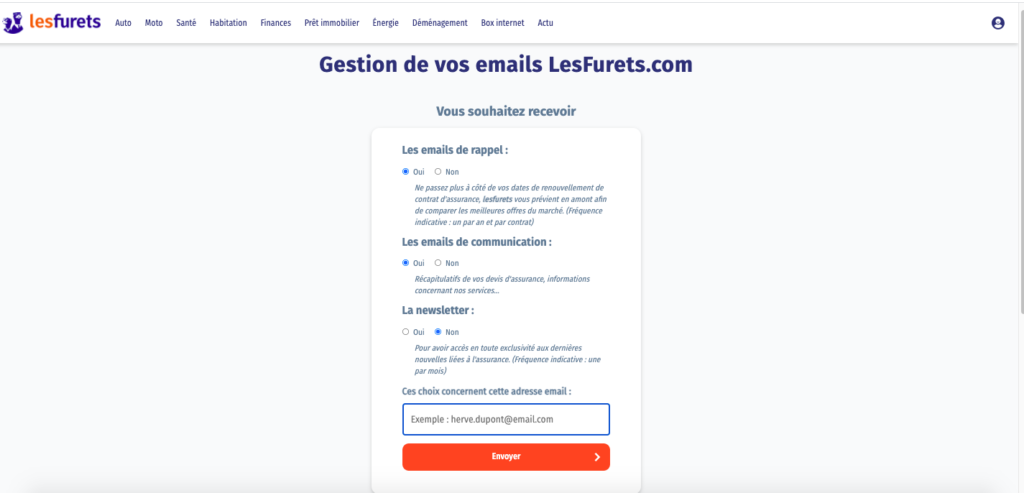
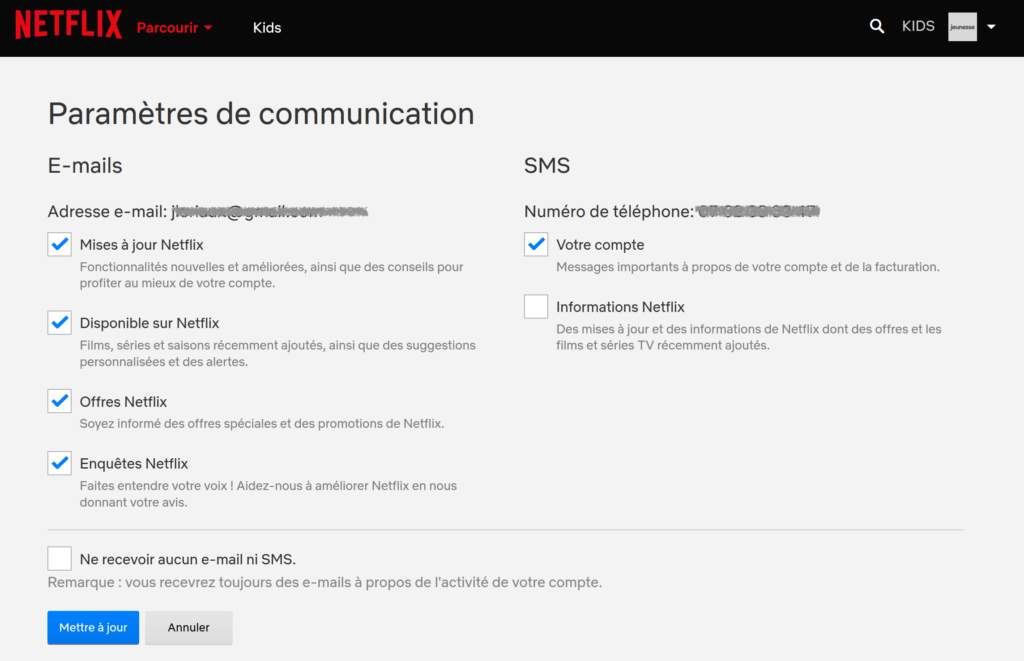
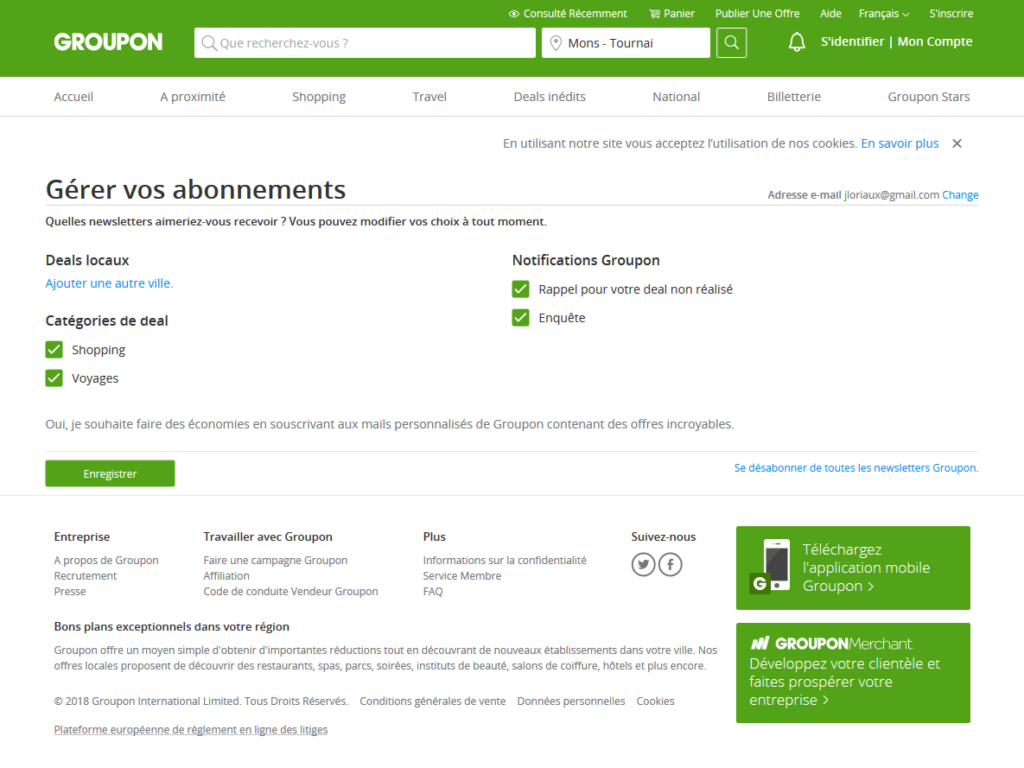
Do you agree that the CP should include ALL contact channels used by a company? Email, SMS, postal mail
Yes !
Is the PC an RGPD standard to be respected in BtoB?
No, it's not a standard. In BtoB it's a bit "open bar", we don't need opt-in legally speaking. Nevertheless, even in B2B, the principle of consent is a good marketing practice. It generates trust. All companies should be able to specify where they got the email address, the phone number... of the people they contact.
Can you show us your PC at Didomi?
Didomi's is quite simple but one could imagine displaying in addition the history of consents and the frequency of communications. This will be implemented later. We need to implement this project by iteration: start setting up a simple PC, use it, see how it reacts (positive or negative results in terms of marketing and legal performance) and optimize it accordingly.
When we talk to our customers about PC, one of the objectives is to improve marketing pressure? Is it really Is it possible to optimize the marketing pressure exerted on your contacts via a PC?
Yes, it's well managed in Hubspot. There's a whole system of lists and workflows that can be set up. Basically, you have to create lists that say "Contacts that agree to receive emails once a month"... when it comes to targeting campaigns, if a contact is on that list and they've already received an email in the month, then they're no longer targeted. This is managed with targeting, exclusion and email priority criteria. In some marketing campaign management tools, this can be done in total autonomy, in others, it will require support in the reflection and implementation.
This question is one of the points that can scare advertisers. For my part, I am not so reassured on this point. In the PCs, I see too few questions about the ideal frequency of receiving emails. If you look at the visuals of the PCs that I have inserted above, not a single one asks the question of the ideal reception frequency... Is it because it is difficult to implement? (targeting rules, exclusions, email priority management...) Friends, routers, if you want to show us during a live session how it is possible to do all this in your tool, you can contact me !
What about opt-in/preferences for cookies also in a 360° vision?
To manage cookies, you need a Consent Management PlatformThis is a cookie management tool that today (especially since the CNIL recommendations that came into force at the beginning of April). In a 360° vision of a client, we can integrate the management of consent/cookie preferences (examples: "yes, I want Google to retarget me" or "hubspot to track my form completion") AND the management of consent/email/direct marketing refernces within the PC. The question to ask is: what will be the identifier? For example, at Didomi, theidentification is done on the basis of the email addressA CMP 'Consent Management Platform' identifies the individual on the basis of his device (=the XYZ computer). So if you want to integrate Preferences cookies + Preferences Direct Marketing, you have to provide a connection between these 2 identifiers. This is technically feasible, but it must be organized. You have to use a common identifier, for example, the login. Or the IP address... Having a centralized management of Cookies+Direct Marketing has many advantages, it allows you to do cross device.
If a user unsubscribes from 'Sales Communication' in your PC, does this mean that a sales person can no longer contact him?
No, it means that Didomi will not send any more commercial communication. But from a good practice point of view, if we know that a contact has unsubscribed from commercial emails, we will avoid contacting them again, even on a one-to-one basis via a sales person. At Didomi, we have set up a system between Hubspot and Salesforce, our sales tool. These 2 tools talk to each other very well so a salesperson at Didomi can see if a contact has unsubscribed from commercial emails.
To note on this visual, that the PC of Easyence, includes the One-to-One emails in its PC.
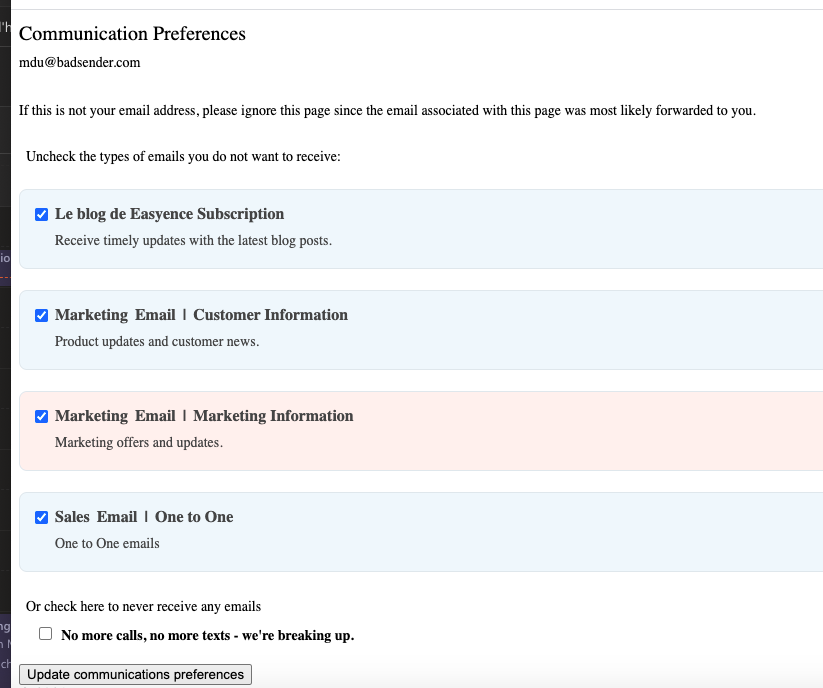
At Didomi, how are your tools (Hubspot and Salesforce) connected to your PC?
Through API systems, it was quite easy to set up:
- Hubspot communicates with Salesforce
- and Hubspot communicates with the Didomi PC. For our first version, we chose to put Hubspot in the center but it could also be the Didomi PC in the center. Our strategy is quite simple, so Hubspot in the center is fine. However, if we have a multi-brand system, that's not what we would recommend. That would be the Didomi PC in the middle.
So the overall reco is to use a third party tool to set up a PC? Or to use your routing tool? Is there a better practice than another?
It depends on the objectives and the number of channels used. If you are a company without multi-brand, multi-channel issues and with strong agility needs, a PC directly integrated with a routing tool can work very well. We (Didomi) could have done everything in Hubspot. But we didn't find 100% to be the best and we have our own third party tool so it would be a shame to do without it. In fact, we found that Hubspot's PC was not very nice, nor well thought out, we wanted to do better.
As soon as you start adding other channels, other connection tools, (like Aircall at Didomi which is the call center tool), it becomes less manageable from a routing tool and you need a dedicated third party tool.
So, in conclusion, when you use only one routing tool, and you use the email channel (and even SMS because SMS are often routed via email routing tools), even if you are multi-brand (provided that all the consent data of these different brands are in the same routing tool), setting up your PC in your routing tool can do the trick. But as soon as you use a lot of communication channels (email, phone, mail, social networks, push notification...) and you use several routing tools and you need a centralized view, the third party tool is more appropriate. And if on top of that, we need to redistribute the data to partners...
How do we communicate once the PC is in place?
From a "good strategic practice" perspective:
- The PC should be highlighted via an email "preference updates". This email should be placed within a welcome scenario. Welcome scenario emails are usually read at 70%, so this is a great visibility opportunity to get your PC in the spotlight.
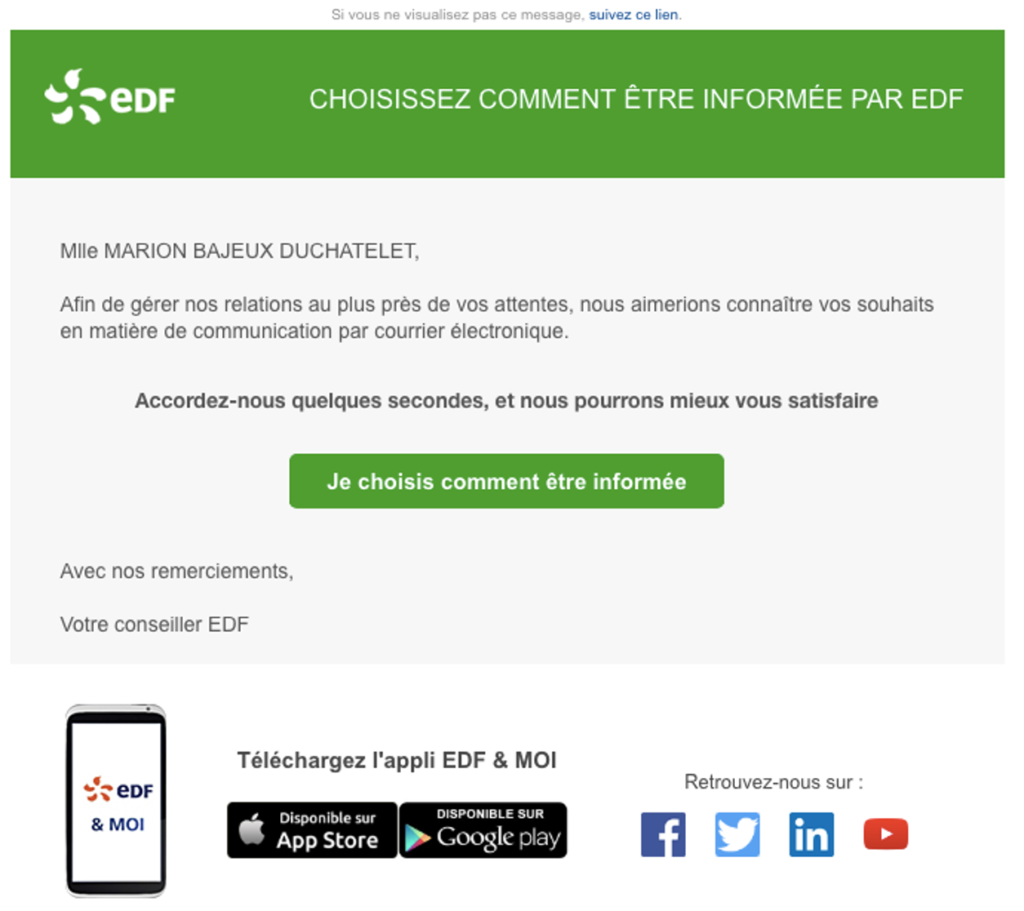
- Next, it is also necessary to think of updating the scenario of reactivation of the inactive addresses. When the third email says "Do you REALLY want to unsubscribe from our communications?", we can propose an alternative that aims to reduce the frequency of sending and of course send back to the PC.
- To notify your contacts who are already in the base (and who have passed the welcome cycle), you can send the "Preferences Update" email to your entire base (at least... the active ones -6 months old!) to notify your existing contacts about the PC. But you shouldn't expect to get a lot of clicks. It's still a one shot email.
- Finally, all your emails (newsletters, promotional emails but also emails from your life cycles) must include a link like "To update your communication preferences, click here". This link must be accessible in each header AND each footer and placed next to the "Unsubscribe" link.
Didomi has put together a tip When their contacts click on "Unsubscribe", they are presented with a landing page that says "Unsubscribe...you mean update your preferences? Are you sure you want to unsubscribe from everything? "They assume that PC is not yet well known to the general public (and it's true, I see it every time I I give training). They give, of course, the possibility to unsubscribe globally from all communications but they push the user to discover the PC.
Does the unsubscribe link have to go back to the PC?
No, not necessarily. The user is used to the "Unsubscribe" link. So it should be kept. In addition, it's a bit touchy step. If you force the user to do something else, he might not take it well. On the other hand, you can be educational and tell them that from now on they can only unsubscribe to certain types of communication.
So to summarize, we will have 2 links in each email:
- a link to update communication preferences to the PC
- an unsubscribe link that will be educational and will offer him to unsubscribe from certain communications AND from all communications. Be careful, the law requires an easy unsubscription, you must ensure that the contact can always unsubscribe from EVERYTHING in 2 clicks max. Ideally, you should do an A/B test between 2 unsubscribe pages. The 'classic' vs the 'educational' one!
Do you have any feedback on its use? Is the PC really used by the contacts? Do they like to use it to modify their data?
There is still little feedback on the use of PCs. The only feedback we have so far is that those who are implementing PCs are happy with them.
Where we are convinced is that this is going in the right direction, towards a more ethical marketing where recipients are asked from the beginning of the collection of communication preferences. The objective is that these preferences are fulfilled to improve the targeting and personalization strategy, to send fewer emails per individual while increasing the number of openers and clickers!
We will certainly organize a next live in the autumn but with a quantified return this time? So, stay tuned to our lives !
What about the Actito practice? The unsubscribe page offers a "Confirm your unsubscription" button that automatically turns into a "Re-subscribe" button in 0.5 seconds. If you're not careful, you might end up re-subscribing when you wanted to unsubscribe?
Indeed, I just tested it. This technique fulfills the promise of unsubscribing in 1 click! Which is a good thing. But it's true that, as it goes very fast, people could, by habit, click on the green button and, therefore, re-register. This is where we see that the User Experience part is very important. You have to find the right balance between transparency and efficiency of the process.
Suggest topics!
We also organize our lives according to the topics that are on our minds. So don't hesitate! If you have questions about a specific (or even not very specific) topic, send us a message and we'll be happy to break it down in a future live. And if you want to be coached on the Preference Center (or any other topic for that matter), don't hesitate to send us a little message ?
